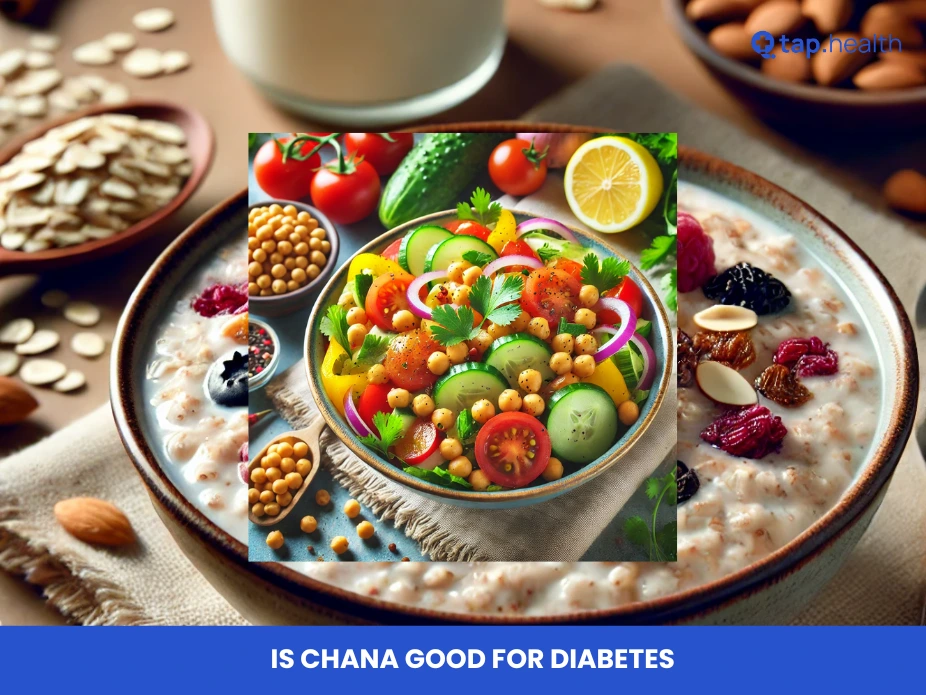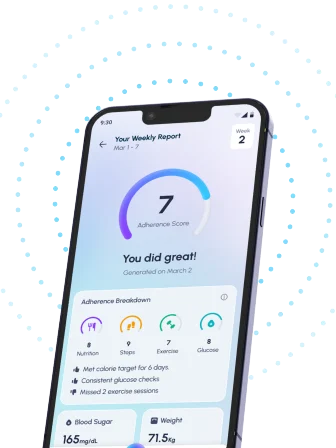Managing diabetes effectively requires making smart dietary choices. One common question people ask is, “Is chana good for diabetes?” Chana, also known as chickpeas, is a versatile legume enjoyed in many cuisines worldwide. This blog post explores how chana can benefit those with diabetes, compares it to other foods, offers delicious recipes, and answers frequently asked questions to help you make informed decisions about including chana in your diet.
Understanding Chana: A Staple Indian Grain
Chana, or chickpeas, are legumes that have been a part of human diets for thousands of years. Originating from the Middle East, they are now a staple in many parts of the world, including India, the Mediterranean, and the Americas. Chana comes in two main varieties:
- Desi Chana: Smaller, darker, and nuttier in flavor, commonly used in Indian dishes.
- Kabuli Chana: Larger, lighter in color, and softer, often found in salads and Mediterranean recipes.
Both types are packed with nutrients, making them a valuable addition to a balanced diet, especially for individuals managing diabetes.
The Basics of Chana: What It Is and Its Varieties
Chana is not just a delicious addition to meals; it is also highly nutritious. Understanding the different varieties can help you incorporate them effectively into your diet.
Desi Chana
- Appearance: Smaller, darker brown.
- Texture: Firmer with a nuttier flavor.
- Uses: Ideal for curries, stews, and traditional Indian dishes like chana masala.
Kabuli Chana
- Appearance: Larger, beige.
- Texture: Softer and milder in taste.
- Uses: Perfect for salads, hummus, and Mediterranean recipes.
Types of Chana
Choosing the right type of chana can enhance its benefits for diabetes management. Here are the primary types available:
- Whole Chana: Retains all nutrients, high in fiber, and has a low glycemic index.
- Chana Flour (Besan): Ground form, versatile for making pancakes, fritters, and desserts.
- Roasted Chana: A crunchy snack option, high in protein and fiber.
- Chana Sprouts: Germinated chickpeas, rich in vitamins and easy to digest.
Which Chana Is Best for Diabetes?
When managing diabetes, whole chana is often the best choice. It maintains its natural fiber and nutrient content, providing sustained energy and stable blood sugar levels. Sprouted chana is also excellent as it is easier to digest and packed with additional vitamins.
Why Chana Holds a Special Place in Indian Cuisine
Chana’s versatility and nutritional benefits have earned it a cherished spot in Indian cuisine. It can be prepared in countless ways, from hearty curries to light salads. Its ability to absorb flavors makes it a favorite choice for many traditional recipes, allowing endless creativity in the kitchen.
Nutritional Breakdown of Chana
Chana is a nutrient-dense food that offers a variety of essential nutrients. Here’s a detailed look at its nutritional profile per 100 grams of cooked chickpeas:
- Calories: 164 kcal
- Carbohydrates: 27 grams
- Protein: 9 grams
- Fiber: 8 grams
- Fat: 2.6 grams
- Vitamins and Minerals: Rich in folate, iron, magnesium, phosphorus, and zinc.
Key Nutrients in Chana and Their Benefits
Carbohydrates
Chana is an excellent source of complex carbohydrates, which provide sustained energy for daily activities and support muscle building. Unlike simple carbs, complex carbohydrates break down slowly, preventing sudden drops in energy levels.
Protein
With 9 grams of protein per 100 grams, chana contains essential amino acids necessary for repairing and building muscle tissues. Protein is crucial for maintaining muscle mass and supporting metabolic functions, especially important for individuals with diabetes.
Fiber
High in dietary fiber, chana aids in digestion and keeps you feeling full longer. This helps prevent overeating and promotes a healthy digestive system. Fiber also plays a role in regulating metabolism, contributing to efficient nutrient absorption.
Vitamins and Minerals
Chana is rich in B vitamins, which are essential for energy metabolism and maintaining a healthy nervous system. Iron is crucial for transporting oxygen in the blood, while magnesium supports muscle and nerve function. Zinc contributes to immune health and protein synthesis.
Is Chana Good for Diabetes?
Yes, chana is excellent for diabetes management. Its high fiber content, low glycemic index, and rich nutrient profile make it a beneficial food choice for individuals with diabetes. Incorporating chana into your diet can help stabilize blood sugar levels, improve insulin sensitivity, and provide sustained energy throughout the day.
Why Chana is Beneficial:
- Low Glycemic Index: Helps in maintaining stable blood sugar levels.
- High Fiber Content: Promotes satiety and aids in digestion.
- Rich in Protein: Supports muscle health and overall metabolism.
- Nutrient-Dense: Packed with vitamins and minerals essential for health.
Potential Benefits of Chana for Diabetes
Incorporating chana into a diabetic diet offers numerous benefits:
- Blood Sugar Control: The low glycemic index and high fiber content help maintain stable blood sugar levels.
- Weight Management: High fiber and protein content promote satiety, reducing overall calorie intake.
- Heart Health: Chana can help lower cholesterol levels, reducing the risk of heart disease, a common complication of diabetes.
- Improved Digestion: Fiber supports a healthy digestive system, preventing constipation and promoting regular bowel movements.
- Nutrient Supply: Provides essential vitamins and minerals that support overall health and metabolic functions.
The Side Effects of Chana Consumption
While chana is generally safe and beneficial, excessive consumption can lead to certain side effects:
- Digestive Issues: Overeating chana can cause bloating, gas, and stomach discomfort due to its high fiber content.
- Allergic Reactions: Some individuals may be allergic to chickpeas, experiencing symptoms like itching, swelling, or difficulty breathing.
- Nutrient Imbalance: Relying too heavily on chana may lead to deficiencies in other essential nutrients if not balanced with a varied diet.
Diabetes-Friendly Chana Recipe to Try
Chana and Paneer Stir-Fry
A protein-rich dish that combines the goodness of chana with paneer and vegetables, perfect for those managing diabetes.
Ingredients:
- 1 cup cooked chana
- 200 grams paneer, cubed
- 1 onion, chopped
- 1 bell pepper, sliced
- 2 tablespoons olive oil
- Spices: turmeric, cumin, salt, and pepper to taste
- Fresh coriander for garnish
Instructions:
- Heat Oil: In a pan, heat olive oil over medium heat.
- Sauté Vegetables: Add chopped onions and bell peppers. Sauté until they become tender.
- Add Paneer and Spices: Add paneer cubes and spices. Cook until the paneer is golden brown.
- Combine with Chana: Mix in the cooked chana and stir-fry for a few minutes to blend the flavors.
- Garnish and Serve: Garnish with fresh coriander and serve hot for a hearty, protein-packed meal.
Comparing Chana’s Nutritional Value to Other Grains
When compared to other grains like rice, oats, and quinoa, chana stands out for its high protein and fiber content. Here’s a comparative overview:
| Nutrient | Chana (100g) | Brown Rice (100g) | Oats (100g) | Quinoa (100g) |
|---|---|---|---|---|
| Calories | 164 kcal | 111 kcal | 389 kcal | 120 kcal |
| Carbohydrates | 27 g | 23 g | 66 g | 21 g |
| Protein | 9 g | 2.6 g | 17 g | 4 g |
| Fiber | 8 g | 1.8 g | 11 g | 2.8 g |
| Fat | 2.6 g | 0.9 g | 7 g | 1.9 g |
Key Takeaways:
- Protein: Chana provides significantly more protein than brown rice and quinoa, making it an excellent choice for muscle building and repair.
- Fiber: With 8 grams of fiber, chana surpasses brown rice and quinoa, promoting better digestion and blood sugar control.
- Calories: Chana offers a moderate calorie count, suitable for both weight management and gain when consumed appropriately.
Overall, chana provides a balanced mix of carbohydrates and proteins, making it a suitable choice for those looking to manage diabetes effectively while maintaining muscle health.
Chana and Diabetes Management
Incorporating chana into a diabetic diet can significantly aid in managing blood sugar levels. Its low glycemic index ensures a gradual release of glucose into the bloodstream, preventing sudden spikes. Moreover, the fiber in chana enhances insulin sensitivity, making it easier for the body to utilize glucose effectively.
Practical Tips:
- Combine with Proteins: Pair chana with high-protein foods like paneer, lentils, or lean meats to maximize muscle growth and blood sugar control.
- Add Healthy Fats: Incorporate sources of healthy fats such as nuts, seeds, or olive oil to increase calorie intake and support overall health.
- Frequent Meals: Include chana in multiple meals throughout the day to maintain a steady calorie surplus and prevent overeating.
How Chana Influences Diabetes Levels
Chana influences diabetes levels through its rich nutrient profile and high fiber content. The complex carbohydrates in chana provide sustained energy, essential for daily activities and physical training. Protein in chana supports muscle repair and growth, which is crucial for maintaining a healthy metabolism. Additionally, the fiber content aids in digestion, ensuring that your body efficiently absorbs the nutrients necessary for managing diabetes.
Benefits:
- Sustained Energy: Prevents energy crashes, allowing for consistent physical activity and muscle building.
- Muscle Repair and Growth: Protein helps in repairing muscle tissues, promoting muscle growth and strength.
- Efficient Nutrient Absorption: Fiber ensures that nutrients are absorbed effectively, maximizing the benefits of your diet.
The Role of Fiber in Chana for Glycemic Control
Fiber plays a pivotal role in managing diabetes by enhancing digestion and ensuring steady nutrient absorption. In chana, fiber helps maintain a healthy digestive system by preventing constipation and promoting regular bowel movements. This ensures that your body efficiently absorbs the nutrients required for diabetes management without any digestive discomfort.
Benefits:
- Promotes Satiety: High fiber content keeps you feeling full longer, reducing the likelihood of overeating unhealthy foods.
- Enhances Digestive Health: Prevents digestive issues, allowing for consistent nutrient absorption.
- Supports Metabolism: Aids in maintaining a healthy metabolism, essential for effective diabetes management.
Creative Ways to Incorporate Chana in a Diabetes Diet
Adding variety to your diet can make diabetes management more enjoyable and sustainable. Here are some creative ways to include chana in your meals:
- Chana Porridge
- Enhancements: Add milk, nuts, and seeds to increase protein and healthy fat content.
- Benefits: A hearty breakfast that provides sustained energy and essential nutrients.
- Chana Upma
- Ingredients: Incorporate vegetables, paneer, and spices for added protein and flavor.
- Benefits: A savory dish that balances carbohydrates with protein, ideal for lunch or dinner.
- Chana Smoothies
- Recipe: Blend cooked chana with fruits, yogurt, and a handful of nuts.
- Benefits: A nutritious and calorie-dense snack that supports muscle growth and diabetes management.
- Chana Salads
- Ingredients: Mix cooked chana with fresh vegetables, nuts, and a protein source like grilled chicken or tofu.
- Benefits: A versatile meal option that combines fiber, protein, and healthy fats.
- Chana Desserts
- Examples: Prepare sweet dishes like chana ladoo or add chana to desserts like brownies for extra protein.
- Benefits: Satisfies sweet cravings while contributing to your daily nutrient intake.
- Chana Burgers
- Recipe: Combine cooked chana with mashed vegetables or lentils to form patties.
- Benefits: A nutritious alternative to traditional meat burgers, rich in protein and fiber.
- Chana Pancakes
- Ingredients: Use chana flour to make pancakes, adding ingredients like bananas and nuts.
- Benefits: A delicious and hearty breakfast option that supports diabetes management.
Potential Risks of Overconsumption of Chana for Diabetes
While chana can aid in diabetes management, overconsumption can lead to several potential risks:
- Excess Calorie Intake: Consuming too many calories can result in unwanted weight gain, which may complicate diabetes management.
- Digestive Problems: High fiber intake can cause bloating, gas, and stomach discomfort.
- Nutrient Imbalance: Relying heavily on chana may lead to deficiencies in other essential nutrients.
- Increased Blood Pressure: For some individuals, excessive intake might contribute to elevated blood pressure levels.
Mitigation Strategies:
- Balanced Diet: Ensure a varied diet by incorporating different food groups alongside chana.
- Moderate Portions: Stick to recommended serving sizes to prevent excessive calorie and fiber intake.
- Consult a Dietitian: Seek professional advice to tailor your diet according to your specific health needs and goals.
Best Time to Eat Chana for Maximum Benefits
Incorporating chana into your diet at various times can maximize its benefits for diabetes management and overall health:
- Breakfast: Start your day with a hearty chana porridge loaded with proteins and healthy fats.
- Lunch and Dinner: Use chana as a base for main dishes, ensuring sustained energy throughout the day.
- Snacks: Enjoy chana-based snacks like hummus with vegetables or roasted chana to maintain a steady nutrient intake.
- Post-Workout: Consume chana with proteins post-exercise to aid in muscle recovery and growth.
Which Grain Is Better for a Diabetes Breakfast: Oats or Chana?
Both oats and chana are excellent choices for a diabetes-friendly breakfast, but chana has a slight edge due to its higher protein content. Chana provides more protein and complex carbohydrates compared to oats, making it better suited for those looking to build muscle mass and maintain stable blood sugar levels. Additionally, chana’s versatility allows for a broader range of meal options, catering to different taste preferences and nutritional needs.
Comparative Benefits:
- Oats: High in soluble fiber, excellent for heart health, and easy to prepare.
- Chana: Higher in protein and complex carbohydrates, versatile in both sweet and savory dishes.
Conclusion:
Both grains offer significant benefits, but for those specifically targeting diabetes management with a focus on protein intake, chana may be the more advantageous choice. Incorporating both into your diet can provide a balanced nutrient intake, leveraging the unique benefits of each grain.
Is Chana Better Than Roti for People with Diabetes? (Chana vs Roti)
When comparing chana to roti, chana often emerges as the better option for diabetes management. This is primarily due to chana’s higher carbohydrate and protein content, which are essential for maintaining muscle mass and stabilizing blood sugar levels.
Reasons Why Chana is Better:
- Higher Caloric Content: Chana provides more calories per serving compared to roti, aiding in creating a calorie surplus necessary for sustained energy.
- Balanced Nutrients: Offers a balanced mix of carbohydrates and proteins, essential for muscle growth and repair.
- Versatility: Can be used in various dishes, allowing for creative and nutrient-dense meal options.
Comparative Analysis:
- Roti: Typically made from refined or whole wheat flour, roti can be lower in protein and higher in simple carbohydrates, which may cause quicker spikes in blood sugar levels.
- Chana: Provides a more substantial calorie and protein boost, making it a better choice for those focused on diabetes management and muscle health.
Conclusion:
For individuals managing diabetes, chana is generally a better option than roti due to its higher carbohydrate and protein content, which contribute to muscle growth and overall blood sugar stabilization. However, roti can still be part of a balanced diet when combined with other protein-rich foods.
Does Chana Contain Diabetes-Friendly Nutrients?
Yes, chana contains the necessary nutrients to support diabetes management. Its high carbohydrate and protein content provide the energy and building blocks needed for maintaining muscle mass and overall health. Additionally, chana is nutrient-dense, supplying essential vitamins and minerals that contribute to overall well-being, ensuring that diabetes management is accompanied by improved nutrition rather than just increased calorie intake.
Delicious and Healthy Chana Recipes for Diabetes
Incorporating chana into your diet doesn’t have to be monotonous. Here are some tasty and nutritious recipes to help you manage diabetes healthily:
Chana and Paneer Stir-Fry
A protein-rich dish that combines the goodness of chana with paneer and vegetables.
Ingredients:
- 1 cup cooked chana
- 200 grams paneer, cubed
- 1 onion, chopped
- 1 bell pepper, sliced
- 2 tablespoons olive oil
- Spices: turmeric, cumin, salt, and pepper to taste
- Fresh coriander for garnish
Instructions:
- Heat Oil: In a pan, heat olive oil over medium heat.
- Sauté Vegetables: Add chopped onions and bell peppers. Sauté until they become tender.
- Add Paneer and Spices: Add paneer cubes and spices. Cook until the paneer is golden brown.
- Combine with Chana: Mix in the cooked chana and stir-fry for a few minutes to blend the flavors.
- Garnish and Serve: Garnish with fresh coriander and serve hot for a hearty, protein-packed meal.
Chana and Banana Smoothie
A nutritious and calorie-dense smoothie perfect for a post-workout snack or a quick breakfast.
Ingredients:
- 1/2 cup cooked chana
- 1 banana
- 1 cup milk or almond milk
- 2 tablespoons honey
- A handful of nuts (almonds, walnuts)
- A pinch of cinnamon (optional)
Instructions:
- Blend Ingredients: Combine all ingredients in a blender until smooth.
- Serve: Pour into a glass and enjoy a creamy, energy-boosting smoothie.
- Optional: Sprinkle a pinch of cinnamon on top for added flavor and health benefits.
Chana and Vegetable Salad
A refreshing and nutrient-packed salad that combines the fiber-rich chana with fresh vegetables and a protein source.
Ingredients:
- 1 cup cooked chana, cooled
- 1 cucumber, diced
- 1 tomato, diced
- 1/2 cup corn kernels
- 1/2 cup chickpeas, cooked
- 2 tablespoons olive oil
- Juice of 1 lemon
- Salt and pepper to taste
- Fresh herbs (mint or cilantro) for garnish
Instructions:
- Prepare Ingredients: In a large bowl, combine the cooked chana, cucumber, tomato, corn, and chickpeas.
- Dress the Salad: Drizzle olive oil and lemon juice over the salad. Season with salt and pepper.
- Mix and Garnish: Toss the salad well to ensure all ingredients are evenly coated. Garnish with fresh herbs.
- Serve: Enjoy immediately or refrigerate for a cool, nutritious meal.
Chana Pancakes
A hearty breakfast option that blends the texture of pancakes with the nutritional benefits of chana.
Ingredients:
- 1 cup chana flour
- 1 cup milk
- 2 eggs
- 2 tablespoons honey or maple syrup
- 1 teaspoon baking powder
- 1/2 teaspoon vanilla extract
- A pinch of salt
- Butter or oil for cooking
Instructions:
- Prepare Batter: In a bowl, mix chana flour, baking powder, and salt. In another bowl, whisk milk, eggs, honey, and vanilla extract.
- Combine Ingredients: Gradually add the wet ingredients to the dry ingredients, stirring until smooth.
- Cook Pancakes: Heat a non-stick pan and add a small amount of butter or oil. Pour a ladleful of batter onto the pan and cook until bubbles form on the surface. Flip and cook the other side until golden brown.
- Serve: Serve hot with additional honey, fruits, or a dollop of yogurt.
Chana and Chicken Soup
A nourishing soup that combines chana with chicken and vegetables for a complete meal.
Ingredients:
- 1 cup chana
- 200 grams chicken breast, diced
- 1 onion, chopped
- 2 carrots, sliced
- 2 celery stalks, chopped
- 2 tablespoons olive oil
- 4 cups chicken broth
- Spices: thyme, bay leaf, salt, and pepper to taste
- Fresh parsley for garnish
Instructions:
- Sauté Ingredients: Heat olive oil in a large pot. Sauté onions, carrots, and celery until tender.
- Add Chicken: Add diced chicken breast and cook until browned.
- Add Chana and Broth: Stir in chana and pour in the chicken broth. Add spices.
- Simmer: Bring the mixture to a boil, then reduce heat and let it simmer until chana and chicken are cooked through.
- Garnish and Serve: Remove bay leaf, garnish with fresh parsley, and serve hot.
Expert Opinion on This
Nutritionists agree that incorporating whole grains and legumes like chana into your diet can significantly aid in diabetes management and healthy weight gain. Dr. Anjali Mehta, a dietitian at Healthline, states, “Chana is an excellent choice for those managing diabetes and aiming for healthy weight gain. Its balanced mix of carbohydrates, protein, and fiber helps in maintaining stable blood sugar levels while supporting muscle growth.” She emphasizes the importance of balancing chana with other nutrient-rich foods to prevent potential side effects like digestive issues and nutrient imbalances [^1].
Additionally, Dr. Mehta advises consulting with a healthcare professional or a registered dietitian before making significant dietary changes, especially for individuals with underlying health conditions.
FAQs
1. Can Chana Be Consumed Daily for Diabetes?
Yes, chana can be consumed daily for diabetes management. However, it’s essential to balance it with other nutrient-rich foods to ensure a well-rounded diet and prevent nutrient deficiencies. Incorporating a variety of protein sources, healthy fats, and vegetables alongside chana can help achieve effective diabetes management [^1].
2. Which Is Better for Diabetes: Oats or Chana?
Both oats and chana are beneficial for diabetes, but chana has a higher protein content, making it slightly better for muscle building and sustained energy. Chana’s complex carbohydrates provide steady energy, while oats offer high soluble fiber beneficial for heart health. For optimal diabetes management, incorporating both can provide a balanced nutrient intake [^2].
3. How Is Chana Good for Diabetes?
Chana is high in carbohydrates and protein, providing the energy and building blocks needed for muscle growth and overall health. Its nutrient density ensures that diabetes management is healthy and sustainable, supporting both energy needs and metabolic functions [^3].
4. What Are Some Ways to Incorporate Chana into a Diabetes-Friendly Diet?
- Breakfast porridges with added nuts and seeds.
- Savory dishes like upma or khichdi with vegetables.
- Smoothies blended with fruits and yogurt.
- Salads mixed with vegetables and a protein source like grilled chicken or tofu.
- Snacks like chana-based energy bars or trail mixes.
5. How Does the Glycemic Index of Chana Compare to Other Grains for Diabetes?
Chana has a lower glycemic index compared to refined grains like white rice and some types of bread, making it a better option for maintaining stable blood sugar levels. Its fiber content further enhances its ability to regulate glucose absorption, which is beneficial for sustained energy and muscle growth [^4].
6. What Is the Best Time to Eat Chana?
Chana can be eaten at any meal—breakfast, lunch, dinner, or as a snack. For diabetes management, incorporating it into multiple meals can help maintain steady blood sugar levels. For example, a chana porridge at breakfast and chana-based snacks between meals can effectively contribute to balanced blood sugar levels.
7. Does Chana Increase Blood Sugar Levels?
Chana can help manage blood sugar levels due to its high fiber content, which slows the absorption of glucose. However, consuming it in large quantities without balancing it with proteins and fats can lead to increased blood sugar levels. Moderation and balanced meal planning are key [^3].
8. How Much Chana Can People with Diabetes Consume in a Day?
For diabetes management, consuming 1-2 cups of cooked chana per day is generally recommended. It’s important to pair it with proteins, healthy fats, and vegetables to ensure a balanced diet. This quantity provides sufficient nutrients without overconsumption [^1].
9. How to Prepare Chana for Diabetes?
To prepare chana for diabetes management, cook it with minimal oil and add vegetables and lean proteins like chicken or paneer. Incorporate spices like turmeric and cumin for added flavor and health benefits. This enhances its nutrient content, making it ideal for diabetes-friendly meals [^4].
10. Wheat Chana Glycemic Index
Wheat chana has a glycemic index of around 28-36, which is considered low. This makes it a suitable option for maintaining stable blood sugar levels, especially beneficial for individuals aiming for steady energy release and muscle growth [^2].
11. Disadvantages of Eating Chana
- High Fiber Content: Can cause digestive discomfort if consumed excessively, such as bloating and gas.
- Caloric Density: Overeating can lead to unwanted fat gain rather than muscle mass.
- Nutrient Imbalance: Relying too much on chana may result in missing out on other essential nutrients necessary for overall health.
12. Is Barley Chana Good for Diabetes?
Yes, barley chana is excellent for diabetes management. Barley has a high fiber content and provides additional proteins, which can aid in muscle building and overall health. Incorporating barley chana into meals can offer a variety of flavors and enhance the nutritional profile of your diet [^5].
13. Is Chana Good for High Blood Pressure?
Chana is beneficial for high blood pressure as it is low in sodium and rich in potassium, which helps in managing blood pressure levels. Its fiber content also aids in overall heart health by reducing cholesterol levels and improving cardiovascular function.
14. Is Chana Good for Kidney Patients?
Chana can be included in the diet of kidney patients, but it’s essential to monitor the intake of certain minerals like potassium and phosphorus. Individuals with kidney issues should consult with a healthcare provider or dietitian to tailor their diet according to their specific needs and restrictions.
15. Is Oats Good for Diabetes?
Yes, oats are good for diabetes as they are rich in complex carbohydrates and provide sustained energy. Oats also contain protein and healthy fats, which are essential for muscle growth and overall health. Incorporating oats into your diet can complement chana for a balanced nutrient intake [^2].
16. Can We Eat Chana for Diabetes?
Absolutely! Chana is an excellent choice for diabetes management due to its high carbohydrate and protein content, which provide the necessary energy and nutrients for maintaining stable blood sugar levels. Its versatility allows for a variety of meal options, making it easier to incorporate into your diet [^1].
17. Is Wheat Chana Good for Diabetes?
Yes, wheat chana is particularly good for diabetes management. Its high carbohydrate and protein content make it an ideal choice for those looking to maintain muscle mass and overall health. Additionally, wheat chana is rich in essential vitamins and minerals that support metabolic functions and diabetes control.
18. Does Chana Increase Diabetes?
Consuming chana does not increase diabetes; in fact, it helps in managing diabetes by stabilizing blood sugar levels. However, eating chana in excessive quantities without balancing it with other nutrients can lead to weight gain, which may complicate diabetes management.
19. Which Chana Is Best?
Whole chana is generally considered the best for diabetes management due to its balanced nutrient profile, including high carbohydrates and protein content. Its versatility in various recipes also makes it a practical choice for incorporating into daily meals.
20. Which Chana Is Best for Diabetes?
Barley chana is often recommended for diabetes due to its higher fiber and protein content compared to other types of chana. The additional fiber supports digestive health, while the extra protein aids in muscle building and repair [^5].
21. Can Diabetic Individuals Eat Chana Daily?
Yes, individuals managing diabetes can eat chana daily. However, it’s crucial to ensure a balanced diet by including proteins, healthy fats, and vegetables alongside chana. This balance prevents nutrient deficiencies and promotes effective diabetes management.
22. Is Chana Better Than Roti?
Chana and roti serve different nutritional purposes. For diabetes management, chana is often better due to its higher carbohydrate and protein content, which are essential for maintaining muscle mass and stabilizing blood sugar levels. Roti, especially those made from refined flour, can cause quicker spikes in blood sugar levels, making chana a more suitable choice for stable energy and diabetes control.
23. What Is the Disadvantage of Chana?
The main disadvantages of chana include:
- High Fiber Content: Can cause digestive issues like bloating and gas if consumed excessively.
- Caloric Density: Overeating can lead to unwanted fat gain rather than muscle mass.
- Nutrient Imbalance: Relying too much on chana may result in missing out on other essential nutrients necessary for overall health.
24. Is Chana Good for Cholesterol?
Yes, chana can help in managing cholesterol levels. Its high fiber content, especially soluble fiber, helps reduce LDL (bad) cholesterol levels in the blood. Additionally, the presence of healthy fats when chana is prepared with ingredients like nuts and seeds further aids in maintaining healthy cholesterol levels.
25. Is Chana Good for Weight Loss?
While chana is excellent for diabetes management, it can also aid in weight loss when consumed as part of a balanced diet. Its high fiber content promotes satiety, helping to control appetite and reduce overall calorie intake. By incorporating chana into a calorie-controlled diet, individuals can achieve weight loss goals while maintaining nutritional balance.
26. Is Chana Good for Fat Loss?
Yes, chana can support fat loss by keeping you full for longer periods, thereby reducing the tendency to overeat. Combined with regular exercise, it can be an effective part of a fat loss diet. Its high fiber and protein content ensure that you stay satiated, preventing unnecessary snacking and promoting healthy fat loss.
27. Chana vs Oats for Diabetes
Both chana and oats are nutritious, but chana has a higher protein content, making it slightly better for diabetes management. However, incorporating both into your diet can provide a balanced nutrient intake, leveraging the unique benefits of each grain. For instance, starting the day with chana porridge and enjoying oats as a snack can offer a comprehensive nutritional profile.
Conclusion
Chana is a versatile and nutrient-dense legume that can significantly aid in diabetes management and healthy weight gain. Its high carbohydrate and protein content make it an excellent choice for those looking to build muscle and maintain overall health. Additionally, chana’s benefits extend to managing cholesterol and promoting heart health. Its versatility in various recipes ensures that incorporating chana into your diet can be both enjoyable and beneficial.
However, it’s essential to consume it in moderation and as part of a balanced diet to avoid potential side effects like digestive issues and nutrient imbalances. By creatively incorporating chana into your meals and balancing it with other nutrient-rich foods, you can enjoy its numerous benefits while maintaining a healthy and varied diet.
References
Note: Always consult with a healthcare professional or a registered dietitian before making significant changes to your diet, especially if you have underlying health conditions.




